To add mineral pigments to your soap, mix 1 teaspoon of cosmetic-grade pigment with 1 tablespoon of lightweight oil for cold process soap, or use glycerin for melt-and-pour bases. You'll need basic tools like measuring spoons, mixing bowls, and whisks to achieve even distribution. Start with small amounts (1-2 teaspoons per pound of soap) and build up gradually for desired intensity. For the most reliable results, proper dispersion techniques and quality control measures make all the difference.
Understanding Mineral Pigment Properties and Sources
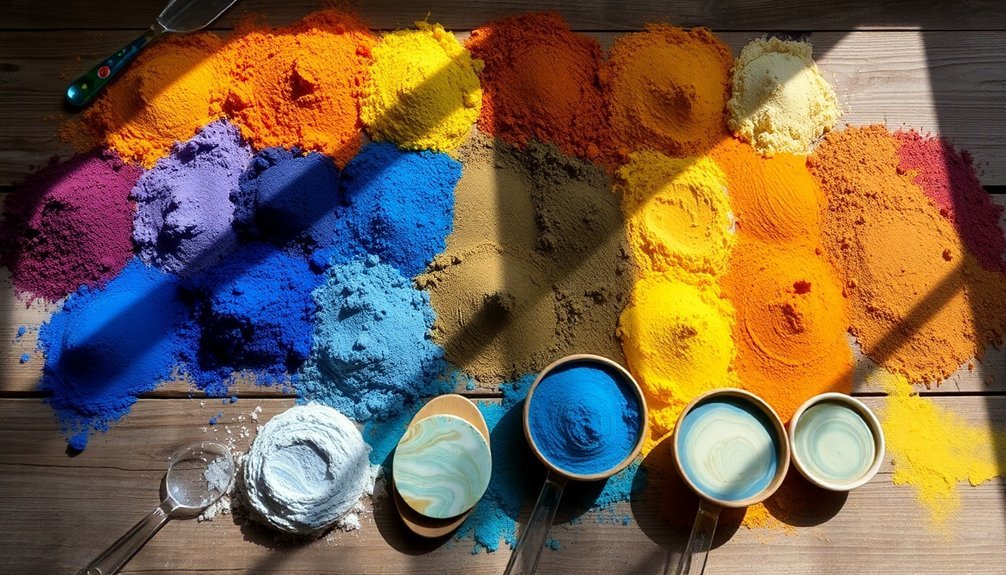
While many soap makers turn to natural colorants, mineral pigments offer a unique combination of stability and vibrancy that's hard to match.
These specialized pigments, including iron oxides and ultramarines, come from natural sources but undergo laboratory refinement to guarantee they're skin safe and pure.
You'll find that mineral pigments excel in color stability, particularly in cold process soap making where they won't bleed or change under high pH conditions.
When you're working with these colorants, stick to 1-2 teaspoons per pound of soap, though you can push to 5-6 teaspoons for more intense shades.
The creative flexibility you'll gain is remarkable – you can achieve everything from earthy tones to vibrant hues in your designs.
This versatility, combined with their reliable performance, makes mineral pigments a go-to choice for consistent, attractive soaps.
Essential Tools and Equipment for Pigment Mixing
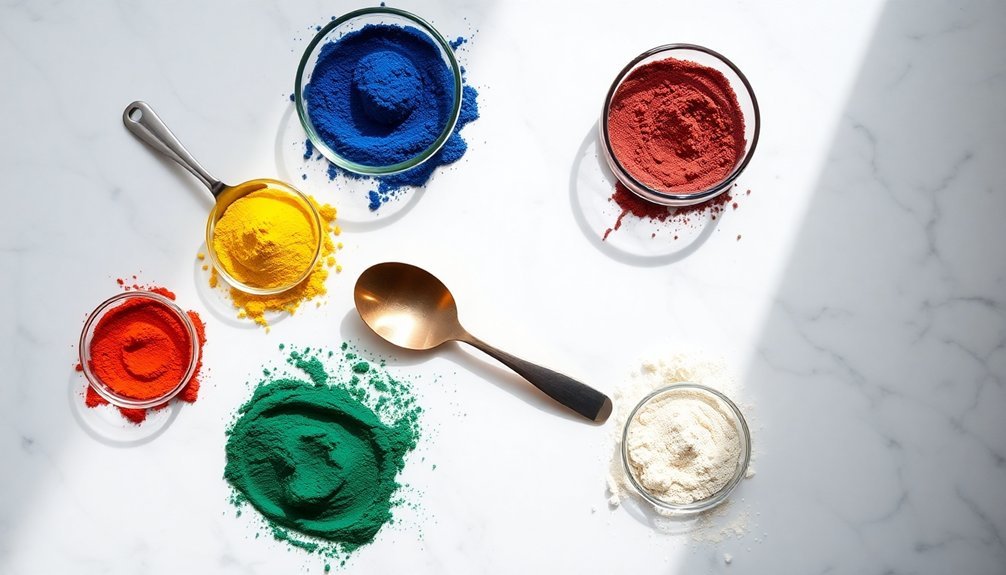
To make the most of mineral pigments, you'll need specific tools that guarantee precise measuring and thorough mixing. Equipped with measuring spoons and a scale, you'll accurately weigh both small and large quantities of colorants. You'll also need a mixing bowl to combine pigments with dispersing agents like oil or glycerin.
| Tool | Purpose | Essential For |
|---|---|---|
| Scale & Spoons | Precise measurements | All pigment types |
| Mixing Bowl | Pigment dispersions | Blending agents |
| Whisk/Blender | Smooth consistency | Even distribution |
| Sieve & Gloves | Safety & preparation | Clean workflow |
For thorough blending, use a whisk or stick blender to eliminate clumps in your pigment dispersions. Don't forget to sift your mineral pigments through a fine sieve before mixing, and always wear disposable gloves to protect your hands from staining.
Proper Dispersion Techniques for Even Color Distribution
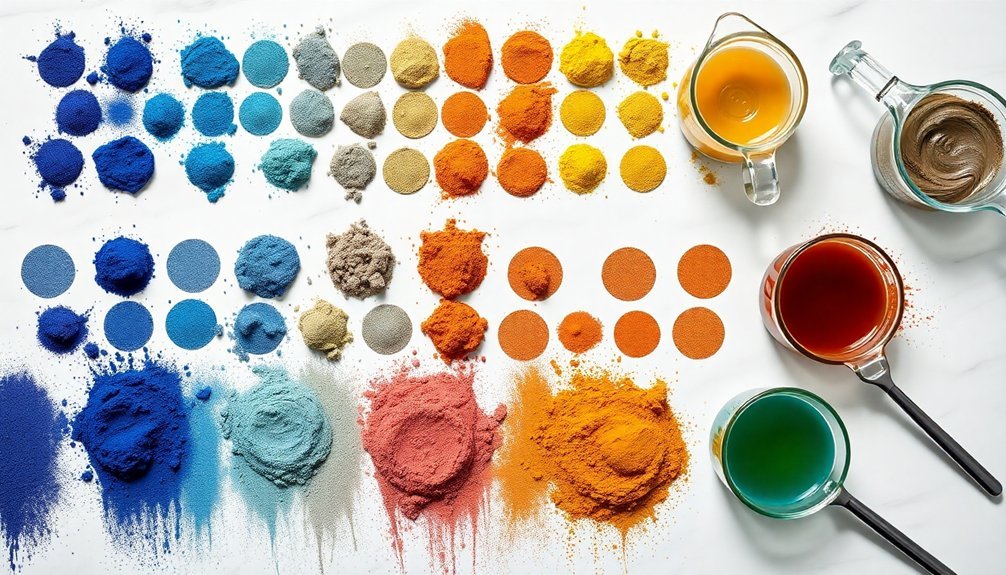
Achieving even color distribution in soap making requires three fundamental dispersion ratios. For proper dispersion techniques with mineral pigments, mix 1 teaspoon of pigment with 1 tablespoon of lightweight oil for cold process soap. Scale up using 2:2 or 3:3 ratios for larger batches. For melt-and-pour soap, use glycerin or alcohol instead of oil for better blending.
For flawless soap colors, blend mineral pigments with oil in a 1:1 ratio, scaling up proportionally for bigger batches.
- Start with 1 dispersed teaspoon per pound of soap
- Mix thoroughly before adding to your soap mixture
- Add dispersed pigments at trace for cold process soap
- Test colorants in small batches first to evaluate results
- Increase pigment gradually until you reach desired color intensity
Remember to maintain consistent ratios while scaling up your batches to guarantee even color distribution throughout your finished soap products.
This method prevents clumping and ensures professional-looking results.
Color Intensity Guidelines and Measurements
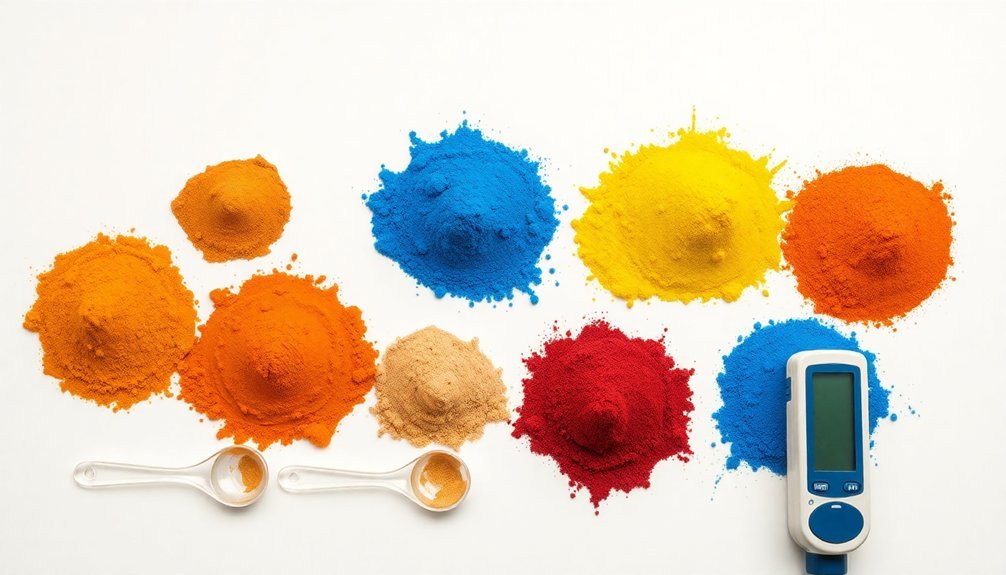
Successful color intensity in soap making depends on precise measurements and careful attention to batch size.
You'll need about 1 dispersed teaspoon of mineral pigment per pound of soap for ideal results. For smaller batches between 50-100 grams, use 1/4 to 1/2 teaspoon of mica, while 100-200 gram batches require 1/2 to 1 teaspoon.
To guarantee consistency in your final shade, mix 1 teaspoon of pigment with 1 tablespoon of lightweight oil before adding it at trace.
Since color intensity can vary based on your soap-making process, it's essential to test small batches first.
Don't forget to record your measurements for each batch – this documentation will serve as a valuable reference for future projects and help maintain uniform results across different batches.
Safety Standards and Quality Control Methods
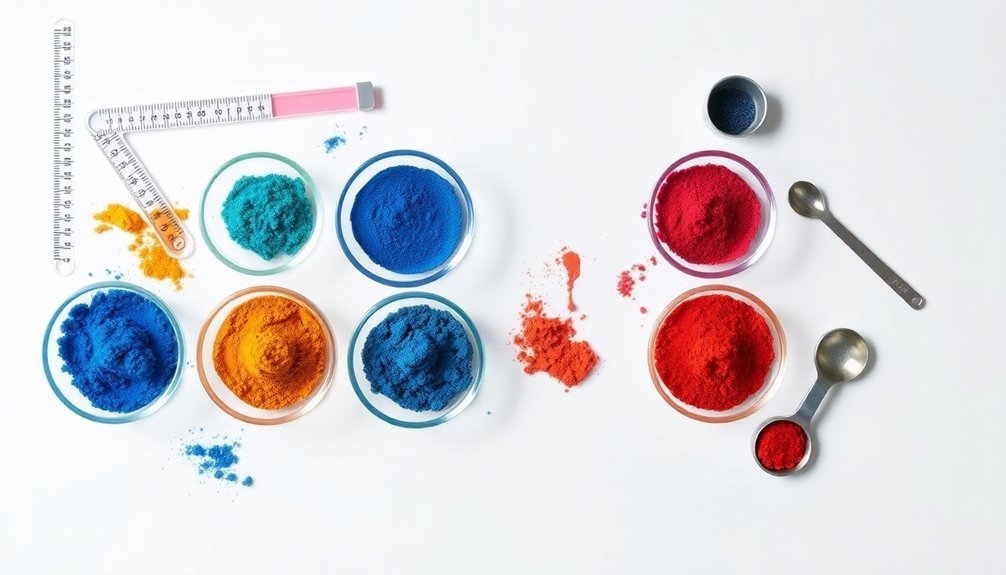
When working with mineral pigments in soap making, safety standards and quality control methods must be your top priority.
You'll want to verify you're using cosmetic-grade mineral pigments that meet FDA guidelines and have undergone proper batch testing. Always confirm that your suppliers follow strict quality control procedures, including testing for heavy metal contamination.
- Look for INCI-compliant labeling on all mineral pigments
- Choose only skin-safe, cosmetic-grade pigments from reputable manufacturers
- Verify that suppliers conduct regular batch testing for consistency
- Confirm pigments meet regulatory bodies' safety standards
- Check documentation for heavy metal contamination test results
Understanding these safety measures protects both you and your customers.
While working with mineral pigments can be exciting, never compromise on quality control procedures or safety standards. Remember, compliant ingredients are essential for creating safe, beautiful soap products.
Storage and Shelf Life Considerations
Proper storage of mineral pigments plays an essential role in preserving their quality and effectiveness for soap making. You'll need to store them in a cool, dry place away from direct sunlight to maintain their vibrant colors. Always use sealed containers to prevent moisture absorption and keep track of their shelf life by labeling containers with purchase dates.
Storage Factor | Impact on Pigments
————–|——————
Temperature | Affects color stability
Humidity | Causes clumping
Light exposure | Degrades pigment quality
Container type | Prevents contamination
Storage location | Maintains freshness
While mineral pigments can last 2-3 years when stored correctly, you'll want to check them before use for any changes in texture or color. Avoid exposing your pigments to extreme temperatures, as heat can greatly impact their performance in your soap making process.
Troubleshooting Common Pigment Issues
If you're seeing clumped pigments or uneven color distribution in your soap, you'll need to premix your mineral pigments with lightweight oil before adding them to your batch.
To prevent color morphing, keep a close eye on your soap's pH levels and consider using pH-stable pigment options that won't fade or change over time.
When you notice unwanted color changes, try reducing your liquid content and test small batches first to guarantee your chosen pigments maintain their intended hue throughout the curing process.
Clumping and Uneven Distribution
One of the most frustrating challenges soap makers face is dealing with mineral pigments that clump or distribute unevenly throughout their soap. To prevent these issues, you'll need to disperse your pigments in lightweight oil or glycerin before adding them to your soap mixture.
Using a high-speed blender can guarantee thorough mixing, while adding pigments at trace helps maintain even distribution. Remember to start with small amounts and gradually increase for ideal color stability.
- Clean and dry your workspace and tools before handling pigments
- Pre-mix pigments with a carrier oil to break up clumps
- Use a stick blender to thoroughly incorporate colors
- Add pigments at trace for better integration
- Gradually increase pigment amounts until reaching desired color
These steps will help you achieve consistent, professional-looking results in your soap making projects.
Color Morphing Prevention Tips
While mastering pigment distribution is important, preventing color morphing presents another key challenge in mineral soap making.
To achieve predictable results, you'll want to start by using only cosmetic-grade mineral pigments that can withstand high pH levels. Before adding pigments to your soap, mix them with a lightweight oil to guarantee even dispersion throughout the saponification process.
Keep in mind that the maximum usage rate shouldn't exceed 5% of your total soap weight to prevent unexpected color shifts.
It's essential to conduct small batch tests with your specific formulation, as some colors may change when exposed to light or air. When mixing colors, start with minimal amounts and build up gradually.
This methodical approach helps you maintain control over your pigments and creates reliable, consistent results in your finished soap.
Managing Ph-Related Changes
Understanding pH-related color changes presents an essential challenge when working with mineral pigments in soap making.
When you're working with cold process soap, the high pH environment can cause unexpected color shifts and fading. To maintain color stability, you'll need to use cosmetic-grade mineral pigments specifically formulated for alkaline conditions.
Here's what you need to know about managing pH effects:
- Mix your mineral pigments with lightweight oil before adding them to trace
- Always conduct a small batch test with new pigments to observe potential changes
- Choose pH-stable, cosmetic-grade pigments designed for soap making
- Store finished soaps in a cool, dry place away from direct light
- Monitor your soap's color development during the curing process
These steps will help you stabilize color and maintain vibrancy in your finished soap products.
Frequently Asked Questions
Can You Put Too Much Mica in Soap?
Yes, you can definitely put too much mica in soap. You'll risk skin staining, fabric discoloration, and poor lather quality. It's best to stick to 1/2-1 teaspoon per pound of soap for ideal results.
How to Mix Colors for Soap Making?
You'll need to disperse your colorants in lightweight oil first – mix 1 teaspoon of pigment with 1 tablespoon of oil. Add this mixture to your soap at trace, stirring well for even distribution.
What Is the Difference Between Pigment and Mica?
You'll find that pigments are lab-created for stability and solid colors, while micas are natural minerals offering shimmer effects. Pigments won't bleed in soap, but micas can migrate due to pH levels.
How Much Mica to Use in CP Soap?
You'll need 1 teaspoon of mica per pound of soap. Mix it with 1 tablespoon of light oil before adding to your soap at trace. Scale up using the same ratio for larger batches.
In Summary
You'll find that mineral pigments open up endless possibilities for creating uniquely colored soaps. By following proper safety protocols, measuring techniques, and dispersion methods, you're well-equipped to craft vibrant, stable soap creations. Remember to store your pigments correctly and document your successful color combinations. With practice and patience, you'll master the art of using mineral pigments in your soap making journey.


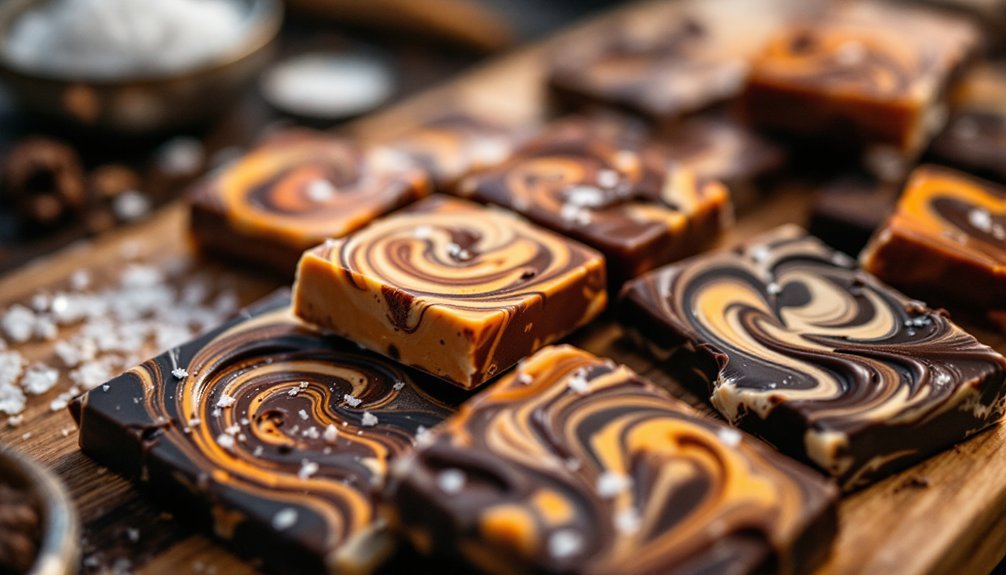
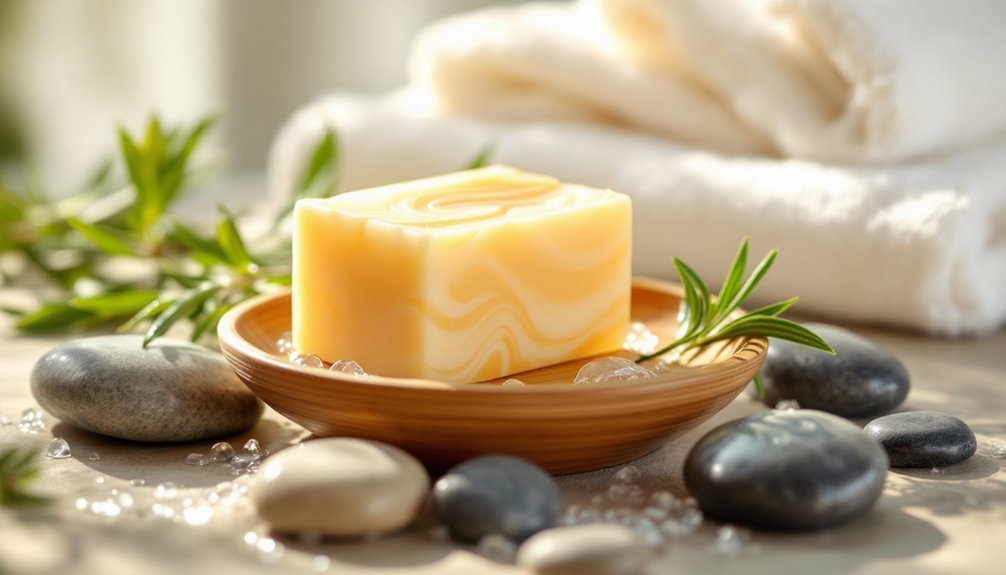
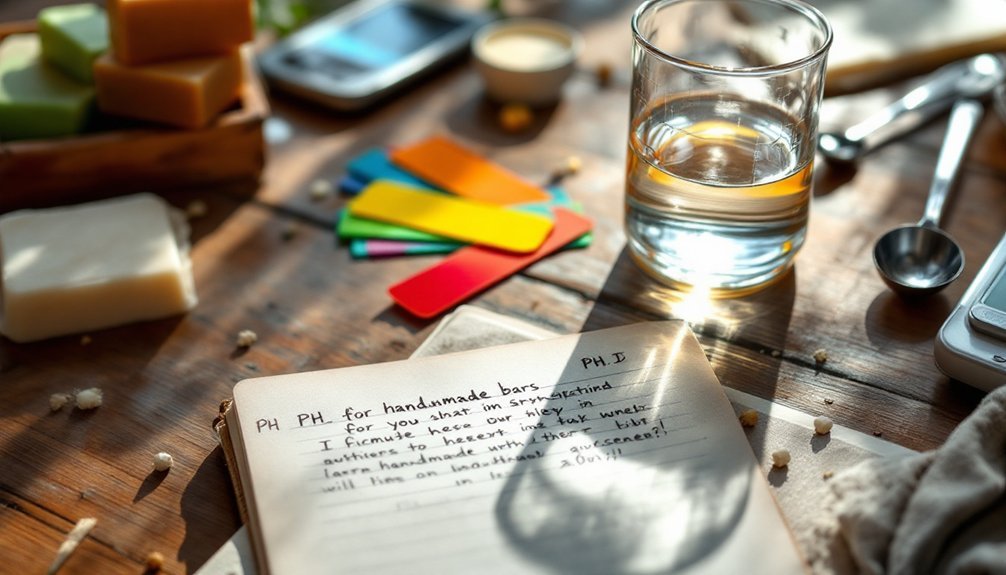
Leave a Reply